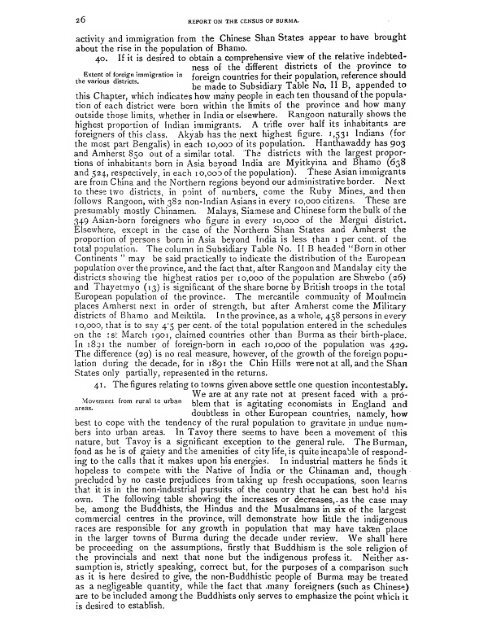Burma: Census of India 1901 Vol. I - Khamkoo
Burma: Census of India 1901 Vol. I - Khamkoo
Burma: Census of India 1901 Vol. I - Khamkoo
You also want an ePaper? Increase the reach of your titles
YUMPU automatically turns print PDFs into web optimized ePapers that Google loves.
26 REPORT ON THE CENSUS OF BURMA.<br />
activity and immigration from the Chinese Shan States appear to have brought<br />
about the rise in the population <strong>of</strong> Bhanio.<br />
40. If it is desired to obtain a comprehensive view <strong>of</strong> the relative indebtedness<br />
<strong>of</strong> the different districts <strong>of</strong> the province to<br />
Extent <strong>of</strong> foreign immigration in<br />
foreign countries for their population, reference should<br />
the vanous districts.<br />
^^ ^ g^;^^No IT Bj appended to<br />
this Chapter, which indicates how many people in each ten thousand <strong>of</strong> the population<br />
<strong>of</strong> each district were born within the limits <strong>of</strong> the province and how many<br />
outside those limits, whether in <strong>India</strong> or elsewhere. Rangoon naturally shows the<br />
highest proportion <strong>of</strong> <strong>India</strong>n immigrants. A trifle over half its inhabitants are<br />
foreigners <strong>of</strong> this class. Akyab has the next highest figure. 1,531 <strong>India</strong>ns (for<br />
the most part Bengalis) in each io,ood <strong>of</strong> its population. Hanthawaddy has 903<br />
and Amherst 850 out <strong>of</strong> a similar total. The districts with the largest proportions<br />
<strong>of</strong> inhabitants born in Asia beyond <strong>India</strong> are Myitkyina and Bhamo (638<br />
and 524, respectively, in each 10,003 <strong>of</strong> the population). These Asian immigrants<br />
are from China arid the Northern regions beyond our administrative border. Next<br />
to these two districts, in point <strong>of</strong> numbers, come the Ruby Mines, and then<br />
follows Rangoon, with 382 non-<strong>India</strong>n Asians in every 10,000 citizens. These are<br />
presumably mostly Chinamen. Malays, Siamese and Chinese form the bulk <strong>of</strong> the<br />
349 Asian-born foreigners who figure in every 10,000 <strong>of</strong> the Mergui district.<br />
Elsewhere, except in the case <strong>of</strong> the Northern Shan States and Amherst the<br />
proportion <strong>of</strong> persons born in Asia beyond <strong>India</strong> is less than 1 per cent, <strong>of</strong> the<br />
total population. The column in Subsidiary Table No. II B headed "Born in other<br />
Continents " may be said practically to indicate the distribution <strong>of</strong> the European<br />
population over the province, and the fact that, after Rangoon and Mandalay city the<br />
districts showing the highest ratios per 10,000 <strong>of</strong> the population are Shwebo (26)<br />
and Thayetmyo (13) is significant <strong>of</strong> the share borne by British troops in the total<br />
European population <strong>of</strong> the province. The mercantile community <strong>of</strong> Moulmein<br />
places Amherst next in order <strong>of</strong> strength, but after Amherst come the Military<br />
districts <strong>of</strong> Bhamo and Meiktila. I n the province, as a whole, 458 persons in every<br />
10,000, that is to say 4*5 per cent, <strong>of</strong> the total population entered in the schedules<br />
on the :st March <strong>1901</strong>, claimed countries other than <strong>Burma</strong> as their birth-place.<br />
In 1851 the number <strong>of</strong> foreign-born in each 10,000 <strong>of</strong> the population was 429.<br />
The difference (29)<br />
is no real measure, however, <strong>of</strong> the growth <strong>of</strong> the foreign population<br />
during the decade, for in 189 1 the Chin Hills were not at all, and the Shan<br />
States only partially, represented in the returns.<br />
41. The figures relating to towns given above settle one question incontestably.<br />
We are at any rate not at present faced with a prd-<br />
^Movemer.t from rural to urban<br />
blem that is agitating economists in England and<br />
doubtless in other European countries, namely, how<br />
best to cope with the tendency <strong>of</strong> the rural population to gravitate in undue numbers<br />
into urban areas. In Tavoy there seems to have been a movement <strong>of</strong> this<br />
nature, but Tavoy is a significant exception to the general rule. The <strong>Burma</strong>n,<br />
fond as he is <strong>of</strong> gaiety and the amenities <strong>of</strong> city life, is quite incapable <strong>of</strong> responding<br />
to the calls that it makes upon his energies. In industrial matters he finds it<br />
hopeless to compete with the Native <strong>of</strong> <strong>India</strong> or the Chinaman and, though<br />
precluded by no caste prejudices from taking up fresh occupations, soon learns<br />
that it is in the non-industrial pursuits <strong>of</strong> the country that he can best ho!d his<br />
own. The following table showing the increases or decreases, . as the case may<br />
be, among the Buddhists, the Hindus and the Musalmans in six <strong>of</strong> the largest<br />
commercial centres in the province, will demonstrate how little the indigenous<br />
races are responsible for any growth in population that may have takfen place<br />
in the larger towns <strong>of</strong> <strong>Burma</strong> during the decade under review. We shall here<br />
be proceeding on the assumptions, firstly that Buddhism is the sole religion <strong>of</strong><br />
the provincials and next that none but the indigenous pr<strong>of</strong>ess it. Neither assumption<br />
is, strictly speaking, correct but, for the purposes <strong>of</strong> a comparison such<br />
as it is here desired to give, the non-Buddhistic people <strong>of</strong> <strong>Burma</strong> may be treated<br />
as a negligeable quantity, while the fact that .many foreigners (such as Chinese)<br />
are to be included among the Buddhists only serves to emphasize the point which it<br />
is desired to establish.

















